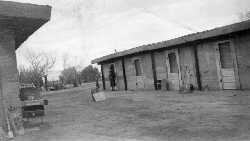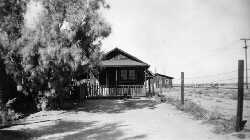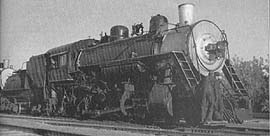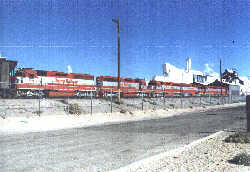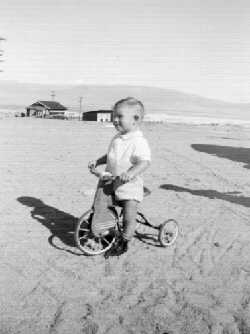Trona on the Web: The Hershel Stevens Family
The following is from my father's autobiography and journal. It explains how our family ended up in Trona. The comments in black italics were written by my sister when she published my parents journal in 1997. I have indicated the comments I added by making them red italics.
On April 4th 1925, I joined the Army and served till 1928 (Daddy spent part of that time in Panama.), and then came home and left for Gary, Indiana, looking for work, as there was where my older brother Arthur lived and worked in the steel mills from 1922 till his death in 1941 on Apr 8th. He died of a heart attack. (Arthur died during the Trona strike, so Daddy was able to go back to the funeral and stay a couple of weeks.) I had no luck finding work there so my youngest brother that went with me to Gary, we took off and went to Dwight, Illinois, where my uncle by marriage Allen Wilkey lived, and he helped land us a job on a construction job, building cement highways.
We worked there till our work played out, and then we went to work on the farms shucking corn. And then we went back to southern Indiana again. At Princeton I landed a job there for a short time working for the Southern Railroad as a section hand and worked at that a while and got laid off again. So then I went back to Gary, Indiana, and found a job working in the National Tube Mills for about four or five months and the plant shut down, and I was laid off again. And I couldn't find work, so I went back to Princeton once again and worked on a farm again. And then come along the depression and from then on out it was...I couldn't find but only a few odd jobs, and they were far apart.
If it hadn't been for my dear old uncle, Ralph Reavis, who still had his job with the Southern shop as a car repairer, helping feed me and my brother Carl, we would of been without a place to stay and without eats. He was a very kind man. I always say that Bud and I didn't miss any meal, but we sure postponed a lot of them. One thing I can say good about that depression, it helped some people that never saved a penny and threw away food and clothes. It sure taught me a lesson that I will never forget. "Save when you have it to save and don't waste anything. There might be another one of those days sometime." I pray never, but the Lord don't want us to waste, and that was one of the ways he had to whip us into knowing.
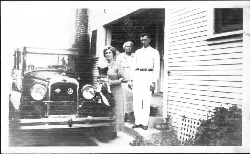
Fay, Addie and Hershel - Photo by unknown
On the 19th of December 1933 my cousin Clemma Fay Eaton and my Aunt Addie McGee came to my rescue and asked a friend of theirs, Cecil Beil, if he could get me a job where he worked in Trona, California, with the American Potash and Chemical Corp. He told them that he would try, so my cousin Fay bought me a ticket to Los Angeles on the Inland Stage Line and my Aunt Addie sent me some money so I could eat on my way out. I left Princeton on the 18th or 19th of December and I landed in Los Angeles around 10 or 10:30 the night of the 22nd of December and went to their home 4511 West 18th St. and stayed till Christmas night. Between the 22nd and 25th, my dear cousin Fay was busy showing me part of Los Angeles and Hollywood which I enjoyed very much. She was busy too. She had lots of friends, and she had lots of gifts to deliver to them, so while showing me around, she got to deliver her gifts to her friends. I sure did enjoy going with her and seeing the town. I even got to see Charlie Chaplin and one of his girlfriends and the Chinese theater in Hollywood. So she tried to keep me happy.
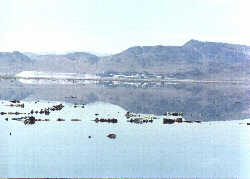
Photo by Michael Stevens Copyright 1996
Then came the big night, Christmas, and their friend took me to Trona with him, and then on the 26th day of December this friend landed me a job in the shipping department for the American Potash and Chemical Corp. I was very happy, of course, to have the job as not having one for so long. He took me up and introduced me to the shipping superintendent, and he told this friend of his and of mine to take me down to shipping and tell Jack Snider, the shipping foreman, to put me to work. So that was the beginning of a 38 year job for me in Trona. I worked hard and tried to make them a good man, which I guess I did or they wouldn't of kept me so long. I was the only man that was hired for some time.

Photo from Kerr-McGee
I worked about three or four days before I filled out a application for a job. The foreman brought it around and gave it to me and said, "I guess you had better take this home and fill it out." Ha, ha! So I did, and I wasn't laid off except for only two days in the 38 years. The company came along and laid off other men that had been with them longer than I. So I thank God that I had a job for that many years. I worked for the American Potash for about 36 of those years and Kerr McGee for two or more out of the 38 years after they bought the Corporation out.
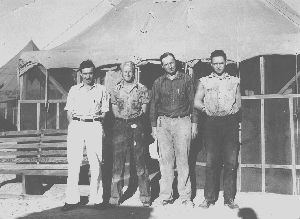
Tent City - Hershel and Friends - Photo by unknown
The first year of my life in Trona was a very lonely year as I didn't know anyone there except new friends that I had met there as I was used to living in a city and had lots of friends which I had to leave to come out there to live on a very hot desert. I worked nights most of the time, and it was very hard to sleep in the daytime as it was so hot.
During the summer months the daytime the temperature ran all the way from 105 to 115 degrees. Hot enough to fry a egg, almost. It was very hard to sleep in the daytime because it was so hot.
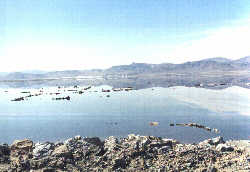
Photo by Michael Stevens Copyright 1996
I lived in what they called tent city which they had for some of the men to sleep in. I would hurry home in the morning after getting off from work and get to bed as soon as I can and could only sleep a couple hours from about 7:30 to 9:30 and would wake up sweating so bad I would just get up, put on my clothes, and walk up town, and sit up there till the sun went down, and go back and sleep a few more hours, and get up and go to work. That was when I was working graveyard shift. When I worked swing shift I come in at night and get to bed around 12 o'clock at night. I could sleep till about 8 or 9 in the morning before it started to get too hot.
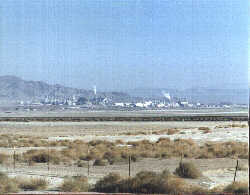
Photo by Michael Stevens Copyright 1996
We didn't know what a cooler was at that time. But later on, we got evaporative coolers in the houses. It wasn't too bad. The first year was the worst year for me being lonely and hot was almost more than I could stand. We did have a open air theater which I did attend quite a lot the first year for my entertainment. My brother Carl came out for a short time, and I got him a job in the shipping, and he worked a short time and lost his job and went to Tucson, Arizona, so I was alone again. I had taken a week off and went to Arizona to see my sister which had moved from Gary, Indiana, to Tucson and when I got back he had lost his job and had took off for Tucson, so I guess we had met on the way. Of course, I didn't see him anymore.
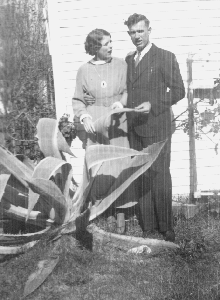 Hershel and Zelia 1933 - Photo by unknown But a little later I met a lovely girl from Georgia and in Jan. 21, 1935, (her name was Zelia Cleo Black) we were united in marriage in Los Angeles at about 12:00 o'clock noon across the street from city hall by a one-armed preacher in the wedding chapel. I was a very happy man. We went and stayed a few days with my dear Aunt Addie McGee, and then I came back to Trona to find a place to live, and the Lord was with me. A friend of mine had a place rented that he had been paying rent on for a couple of months or so as he was going to get married. So he hadn't got married yet, so we sub-rented it from him till he got married, and by that time we had found another place to rent in the same apartments. This place was called a hog ranch. It is now known as the Bowman ranch. It was 23 miles from Trona.
There was no place any closer to Trona to live or at least rent. It was an adobe apartment house. So we did have furniture ordered from Sears which was to be shipped soon, but they shipped it on up to Lone Pine, and we didn't know where it was at. So for almost two weeks we kept going to Inyokern looking for it. Finally we had our cousin Fay to call Sears, and they said it was shipped to Lone Pine, so she told them to ship it to Trona. So in a few days we got it. Our good neighbor loaned us stuff till we got ours. We lived there a few months, and then we moved to Inyokern and lived there by the old Believe It or Not Hotel for almost a year, and then we finally found a house in Borosolvay, about three miles from Trona. We were living in Inyokern when our first child was born, a sweet little girl, which we named Patricia Louise Stevens. We were very proud of her. Then our second one came along, a sweet little boy who was born in Trona Hospital on July the 4th. He was a little firecracker. Ha, ha! He made us very happy and proud of him. We named him Joel.
At that time we lived in Borosolvay which was about three miles south of Trona. The house in Borosolvay used to be a schoolhouse and had four apartments with a hall down the center and a bathroom on one end. I was two and a half years old when Joel was born and one day I decided to take him out of the bassinet and took him down the hall to show him to the neighbors. Joel was an active baby and when he was about four months old would pull himself up on the sides of the bassinet and tip it over, so he had to be moved to a crib. When he was eight months old he learned to walk. Our apartment was heated with an oil heater that sat in the middle of the living room. When he was learning to walk he put his hand on the heater and got a blister that covered the palm of his hand.
A family by the name of Neimeyer lived near the railroad tracks, and they had a little girl Joel's age that he liked to play with. The train usually came during the night, but one morning when Joel was playing with his friend the train was late, and when they saw the train coming, Joel decided to hold a stick on the track and watch the train run over it. The engineer saw them, but thought they were tumbleweeds. By the time he realized they were children, he didn't have time to stop and the step on the engine hit Joel in the head.
When the train stopped everyone in the neighborhood ran to the tracks to see what happened. One of the neighbors (I think it was Webster McNair) took him to the hospital. He had a fractured skull, so they didn't allow him to eat anything for three days. When they asked him what he wanted to eat, he said he wanted a biscuit. They didn't have any biscuits, so they cut a slice of bread into a circle and gave it to him. They said he really gobbled it down. The railroad company paid the doctor bills and gave them an additional one hundred dollars. Mother bought him a suit and hat with part of that money.
At that time the Trona RR had steam engines. The ones I remeber were ran on oil rather than coal. In 1949 the Trona RR bought desel engines much like the ones in the picure above except they were center cab models. When I was 20 I went to work for the San Bernadino City Schools in the maintenance department. One of the men that I worked with there, Jess Kingsford lived in Trona when Joel was hit. He had moved from Trona before I was born. His parents had been friends of my parents, but what Jess remembered most about the family is when Joel was hit by the train.
Joel worked many jobs while a youth in Trona. He worked at the Argus Cheveron Station for many years and as a pin setter in the bowling alley. He was also a varsity Football player and played a tuba in the high school band. Joel joined the Navy when he graduated from high school and after his discharge returned to work in Trona for American Potash and Chemical Corp. and then Stauffer Cemical at west end before finally moving from Trona. We didn't have any way to cool the buildings, so in the summer everyone put their beds outside to sleep. I can remember one morning when we awoke that there was a rattlesnake under Joel's crib. After we had lived there a couple of years, the building was remodeled into two apartments. And then in March 1941 the big strike came along which most of us will not forget as it lasted 104 days. We lived in Borosolvay close to the Billy Goat Hall which was where the union met. The union had a soup kitchen for people while the strike was going on. Our parents never accepted any food from them. Mother had always canned fruit and kept a supply of food on hand, so we never went hungry. The company allowed people to continue to live in their houses without paying rent until the strike was over. Mother said that when the strike was announced everyone just dropped what they were doing and left. There were some men working on a roof who left open buckets of tar. Joel was two and a half years old and found the tar and got it all over himself. Although my father, along with every other employee of America Potash, was a union member my mother never liked or trusted unions. That was very common among people in and from the south.
That was a tough one, but we pulled it through and by that time the company had built more new houses in Trona, and we was able to get one. We lived in a new duplex at 214 Clover Street. Uncle John Black lived with us, and the first thing they did was build in part of the screened-in back porch for a bedroom. The duplexes had only one bedroom. We lived there for a year or better, and then we was able to get a house at 105 Argus Ave., so that is our home now, only they have changed the address. Now it is 83136 Argus. We rented it from the company till 1954 when the company sold all their houses to their employees, and we bought it. Which I can say our house here at 83136 Argus Ave. has been our happy home for about 30 years, since 1942 to 1972.
This house was called an E-type house. It was originally built with one bedroom. It had a screened porch across the full width of the back and another porch across the width of the front. When we moved in, part of the back porch had been converted to a bedroom which I shared with my brothers until I was a senior in high school in 1952. At that time the company moved us into a two bedroom apartment in Wildrose Apartments, while they remodeled our house and added another bedroom on the front. They used half of the front porch as part of the living room and half of the original living room became the bedroom. That was my bedroom. The rent on the house was something like $16 per month. The company had a maintenance crew who painted the houses and kept them in good repair. The company sold the house for $3800 in 1954. After my parents bought the house, they remodeled the house again and added the rest of the front porch to the living room. They also built a patio room on the back.
|
